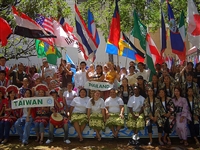Defining culture

Different cultures?
Culture is generally something we all feel we know something about, whether it is our own culture or another culture we are familiar with. However, arriving at a definition of culture is difficult. As Eleanor Ochs has remarked "while culture is considered important to fathom, it is obscure and difficult to analyse. You can't see it; you can't count it in any obvious way" (2002: 115). Nevertheless, there are a number of characteristics of culture and especially its relationship to language and communication which it is important to be aware of.
In these activities you will be introduced to some of the different elements of culture and a range of definitions.
Activity 1: Describing culture
What is culture? Culture is often thought to be an important part of people's lives and who they are. However, deciding what culture is can be very difficult. In this activity you are going to consider some of the different elements that make up culture.
Instruction
Make a list of things which you think make up culture. Then read the feedback. Some examples are given in the help.
Culture is made up of:
Activity 2: Definitions of culture
There are almost as many definitions of culture as there are books on the subject and there is no agreement on one definition of culture that covers everything. In this activity you are going to consider a number of the more influential definitions of culture in relation to language.
Instruction
Read the definitions of culture and decide if you agree or disagree with them. Then read the feedback. The sources of the definitions are given in the feedback.
1. A particular form, stage, or type of intellectual development or civilisation in a society; a society or group characterised by its distinctive customs, achievements, products, outlook, etc.
2. Culture can be thought of as 'Big C' culture—history, geography, institutions, literature, art, music, and the way of life, and 'Little c' culture—culturally influenced beliefs and perceptions expressed mainly through language, but also behaviour including; beliefs, values, customs and habits. Much of this is unconscious.
3. Culture is not innate but learned behaviour.
4. Language is a semiotic system (a system of symbols) that express the culture and society that we live in. The relationship between language, culture and society is interrelated; language influences culture and culture influences language. Language as a social semiotic means, "interpreting language within a sociocultural context, in which culture itself is interpreted in semiotic terms."
5. Culture is much more than food, or singing and dancing, or traditional costumes...it refers to a set of 'agreements' among a group of people, determining how they will behave, how they like to present themselves, how they communicate, what they feel is important, how they see themselves and how they see the world. In short, it is their way of being.
How is culture managed? In other words, how are all these things put into action - all this behaviour and interaction and identity? Through language of course. Language not only expresses culture, it also brings it about.
6. Culture is "1 Membership in a discourse community that shares a common social space and history, and a common system of standards for perceiving, believing, evaluating, and acting. 2 The discourse community itself. 3 The system of standards itself"
7. Culture is not something static as suggested by its classification and use as a noun, but rather dynamic, "Culture is a verb".
8. "Culture is not something fixed and frozen as the traditionalists would have us believe, but a process of constant struggle as cultures interact with each other and are affected by economic, political and social factors."
Definitions of culture reference list (pdf, 65KB). You may wish to print this document.
Would you like to review the main points?
© eLanguages, Modern Languages and Linguistics, University of Southampton, 2010. All rights reserved. Image courtesy of Image courtesy of c_chan808, Flickr.